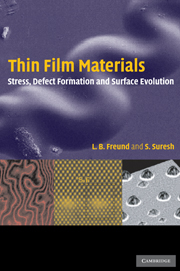Book contents
- Frontmatter
- Contents
- Preface
- 1 Introduction and Overview
- 2 Film stress and substrate curvature
- 3 Stress in anisotropic and patterned films
- 4 Delamination and fracture
- 5 Film buckling, bulging and peeling
- 6 Dislocation formation in epitaxial systems
- 7 Dislocation interactions and strain relaxation
- 8 Equilibrium and stability of surfaces
- 9 The role of stress in mass transport
- References
- Author index
- Subject index
7 - Dislocation interactions and strain relaxation
Published online by Cambridge University Press: 06 July 2010
- Frontmatter
- Contents
- Preface
- 1 Introduction and Overview
- 2 Film stress and substrate curvature
- 3 Stress in anisotropic and patterned films
- 4 Delamination and fracture
- 5 Film buckling, bulging and peeling
- 6 Dislocation formation in epitaxial systems
- 7 Dislocation interactions and strain relaxation
- 8 Equilibrium and stability of surfaces
- 9 The role of stress in mass transport
- References
- Author index
- Subject index
Summary
The issue of dislocation formation in a strained epitaxial heterostructure was the focus of attention in the preceding chapter. Residual stress was assumed to originate from the combination of a mismatch in lattice parameters between the materials involved and the constraint of epitaxy. The discussion in Chapter 6 led to results in the form of minimal conditions which must be met by a material system, represented by a geometrical configuration and material parameters, for dislocation formation to be possible. Once the values of system parameters are beyond the point of fulfilling such minimal conditions, dislocations begin to form, propagate and interact. The ensemble behavior is usually termed strain relaxation.
There are several practical aspects of strain relaxation that originate from the small size scales involved, the relatively low dislocation densities that are observed, and the fact that kinetic processes occur on a timescale comparable to growth or processing timescales. Can significant strain relaxation be suppressed? Can threading dislocation densities be controlled? Under what conditions can ensemble dislocation behavior be captured by a continuum plasticity representation? How do length scales associated with geometrical configuration and microstructure, such as film thickness and grain size, respectively, influence the process of strain relaxation?
Progress toward resolving such questions is summarized in this chapter. The discussion begins with the issue of fundamental dislocation interaction phenomena and nonequilibrium behavior of interacting dislocations. Attention is then shifted from consideration of films with low dislocation density to the modeling of inelastic deformation of thin films with relatively high densities of dislocations.
- Type
- Chapter
- Information
- Thin Film MaterialsStress, Defect Formation and Surface Evolution, pp. 464 - 549Publisher: Cambridge University PressPrint publication year: 2004



